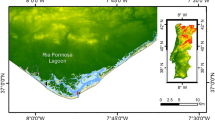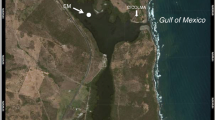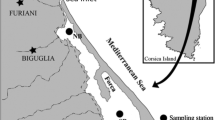Abstract
The growth rates of planktonic microbes in the pelagic zone of the Eastern Mediterranean Sea are nutrient limited, but the type of limitation is still uncertain. During this study, we investigated the occurrence of N and P limitation among different groups of the prokaryotic and eukaryotic (pico-, nano-, and micro-) plankton using a microcosm experiment during stratified water column conditions in the Cretan Sea (Eastern Mediterranean). Microcosms were enriched with N and P (either solely or simultaneously), and the PO4 turnover time, prokaryotic heterotrophic activity, primary production, and the abundance of the different microbial components were measured. Flow cytometric and molecular fingerprint analyses showed that different heterotrophic prokaryotic groups were limited by different nutrients; total heterotrophic prokaryotic growth was limited by P, but only when both N and P were added, changes in community structure and cell size were detected. Phytoplankton were N and P co-limited, with autotrophic pico-eukaryotes being the exception as they increased even when only P was added after a 2-day time lag. The populations of Synechococcus and Prochlorococcus were highly competitive with each other; Prochlorococcus abundance increased during the first 2 days of P addition but kept increasing only when both N and P were added, whereas Synechococcus exhibited higher pigment content and increased in abundance 3 days after simultaneous N and P additions. Dinoflagellates also showed opportunistic behavior at simultaneous N and P additions, in contrast to diatoms and coccolithophores, which diminished in all incubations. High DNA content viruses, selective grazing, and the exhaustion of N sources probably controlled the populations of diatoms and coccolithophores.







Similar content being viewed by others
References
Karl DM (2007) Microbial oceanography: paradigms, processes and promise. Nature 5:759–769
Azov Y (1991) Eastern Mediterranean—a marine desert? Mar Poll Bull 23:225–232
Moutin T, Raimbault P (2002) Primary production, carbon export and nutrients availability in western and eastern Mediterranean Sea in early summer 1996 (MINOS cruise). J Mar Syst 33–34:273–288. doi:10.1016/S0924-7963(02)00062-3
Krom MD, Emeis KC, Van Cappellen P (2010) Why is the Eastern Mediterranean phosphorus limited? Prog Oceanogr 85:236–244. doi:10.1016/j.pocean.2010.03.003
Turley CM, Bianchi M, Christaki U, Conan P, Harris JRW, Psarra S, Ruddy G, Stutt ED, Tselepides A, Van Wambeke F (2000) Relationship between primary producers and bacteria in an oligotrophic sea—the Mediterranean and biogeochemical implications. Mar Ecol Prog Ser 193:11–18
Moutin T, Thingstad TF, Van Wambeke F, Marie D, Slawyk G, Raimbault P (2002) Does competition for nanomolar phosphate supply explain the predominance of the cyanobacterium Synechococcus? Limnol Oceanogr 47(5):1562–1567
Krom MD, Herut B, Mantoura RFC (2004) Nutrient budget for the Eastern Mediterranean: implications for phosphorus limitation. 49:1582–1592. doi: 10.4319/lo.2004.49.5.1582
Wassmann P, Ypma JE, Tselepides A (2000) Vertical flux of faecal pellets and microplankton on the shelf of the oligotrophic Cretan Sea (NE Mediterranean Sea). Prog Oceanogr 46:241–258. doi:10.1016/S0079-6611(00)00021-5
Hartmann M, Grob C, Tarran GA, Martin AP, Burkill PH, Scalan DJ, Zubkov VM (2012) Mixotrophic basis of Atlantic oligotrophic ecosystems. Proc Natl Acad Sci USA 109(15):5756–5760.11
Fouilland E, Mostajir B (2010) Revisited phytoplanktonic carbon dependency of heterotrophic bacteria in freshwaters, transitional, coastal and oceanic water. FEMS Microbiol Ecol 73:419–429. doi:10.1073/pnas.1118179109
Fouilland E, Mostajir B (2010) Revisited phytoplanktonic carbon dependency of heterotrophic bacteria in freshwaters, transitional, coastal and oceanic waters. FEMS Microbiol Ecol 73:419–429. doi:10.1111/j.1574-6941.2010.00896.x
Koch AL (1996) What size should a bacterium be? A question of scale. Annu Rev Microbiol 50:317–348. doi:10.1146/annurev.micro.50.1.317
Tanaka T, Thingstad TF, Christaki U, Colombet J, Cornet-Barthaux V, Courties C, Grattepanche J-D, Lagaria A, Nedoma J, Oriol L, Psarra S, Pujo-Pay M, Van Wambeke F (2011) Lack of P-limitation of phytoplankton and heterotrophic prokaryotes in surface waters of three anticyclonic eddies in the stratified Mediterranean Sea. Biogeosciences 8:525–538
Gilbert JA, Thomas S, Cooley NA, Kulakova A, Field D, Booth T, McGrath JW, Quinn JP, Joint I (2009) Potential for phosphonoacetate utilization by marine bacteria in temperate coastal waters. Environ Microbiol 11(1):111–125. doi:10.1111/j.1462-2920.2008.01745.x
Zohary T, Robarts RD (1998) Experimental study of microbial P limitation in the eastern Mediterranean. Limnol Oceanogr 43:387–395. doi:10.4319/lo.1998.43.3.0387
Thingstad TF, Krom MD, Mantoura RFC, Flaten GAF, Groom S, Herut B, Law CS, Pasternak A, Pitta P, Psarra S, Rassoulzadegan F, Tanaka T, Tselepides A, Wassmann P, Woodward EMS, Wexels Riser C, Zodiatis G, Zohary T (2005) Nature of phosphorus limitation in the ultraoligotrophic Eastern Mediterranean. Science 309:1068–1071. doi:10.1126/science.1112632
Zohary T, Herut B, Krom MD, Mantoura, RFC, Pitta P, Psarra S, Rassoulzadegan F, Stambler N, Tanaka T, Thingstad TF, Woodward EMS (2005) P-limited but N and P co-limited phytoplankton in the Eastern Mediterranean—a microcosm experiment. Deep Sea Res Part 2 Top Stud Oceanogr 52:3011–3023. doi: 10.1016/j.dsr2.2005.08.011
Kirchman D (1994) The uptake of inorganic nutrients by heterotrophic bacteria. Microb Ecol 28:255–271
Sebastián M, Gasol JM (2013) Heterogeneity in the nutrient limitation of different bacterioplankton groups in the Eastern Mediterranean Sea. ISME J 7:1665–8. doi:10.1038/ismej.2013.42
Sala MM, Peters F, Gasol JM, Pedrós-Alió C, Marrasé C, Vaqué D (2002) Seasonal and spatial variations in the nutrient limitation of bacterioplankton growth in the northwestern Mediterranean. Aquat Microb Ecol 27:47–56. doi:10.3354/ame027047
Van Wambeke F, Christaki U, Giannakourou A, Moutin T, Souvemerzoglou K (2002) Longitudinal and vertical trends of bacterial limitation by phosphorus and carbon in the Mediterranean Sea. Microbial Ecol 43:119–133. doi:10.1007/s00248-001-0038-4
Pinhassi J, Gómez-Consarnau L, Alonso-Sáez L, Sala MM, Vidal M, Pedrós-Alió C, Gasol JM (2006) Seasonal changes in bacterioplankton nutrient limitation and their effects on bacterial community composition in the NW Mediterranean Sea. Aquat Microb Ecol 44:241–252. doi:10.3354/ame044241
Thingstad TF (2000) Elements of a theory for the mechanisms controlling abundance, diversity, and biogeochemical role of lytic bacterial viruses in aquatic systems. Limnol Oceanogr 45(6):1320–1328. doi:10.4319/lo.2000.45.6.1320
Gifford SM, Sharma S, Booth M, Moran MA (2012) Expression patterns reveal niche diversification in a marine microbial assemblage. ISME J 7:281–298. doi:10.1038/ismej.2012.96
Ivančič I, Deggobis D (1984) An optimal manual procedure for ammonia analysis in natural waters by the indophenol blue method. Water Res 18:1143–1147. doi:10.1016/0043-1354(84)90230-6
Strickland JDH, Parsons TR (1972) Determination of phosphorus. In: Strickland JDH, Parsons TR (eds) A practical handbook of seawater analysis, 2nd ed, Bulletin No 167. Fisheries Research Board of Canada, Ottawa
Thingstad TF, Skjoldal EF, Bohne RA (1993) Phosphorus cycling and algal-bacterial competition in Sandsfjord, western Norway. Mar Ecol Prog Ser 99:239–259. doi:10.3354/meps099239
Kirchman DEK (2001) Measuring bacterial biomass production and growth rates from leucine incorporation in natural aquatic environments, p. 227–237. In: Paul JH (ed), Marine microbiology. Methods in microbiology, vol 30, St Petersburg, Florida, USA.
Smith S, Azam F (1992) A simple economical method for measuring bacterial protein synthesis rates using 3H leucine. Marine Microbial Food Webs 6:170–114
Fukuda R, Ogawa H, Nagata T, Koike I (1998) Direct determination of carbon and nitrogen contents of natural bacterial assemblages in marine environments. Appl Environ Microb 64(9):3352–3358
Steemann Nielsen E (1952) The use of radioactive carbon (14C) for measuring organic production in the sea. Jour Conseil 18:117–140
Copin-Montegut C (1993) Alkalinity and carbon budgets in the Mediterranean sea. Global Biogeochem Cy 4:915–925
Marie D, Brussaard CPD, Thyrhaug R, Bratbak G, Vaulot D (1999) Enumeration of marine viruses in culture and natural samples by flow cytometry. Appl Environ Microb 65(1):45–52
Marie D, Partensky F, Jacquet S, Vaulot D (1997) Enumeration and cell cycle analysis of natural populations of marine picoplankton by flow cytometry using the nucleic acid stain SYBR Green I. Appl Environ Microbiol 63:186–193
Utermöhl H (1958) Zur Vervollkommung der quantitativen phytoplankton methodik. Mitt Internat Verein Limnol 9:1–38
Massana R, Murray AE, Preston CM, DeLong EF (1997) Vertical distribution and phylogenetic characterization of marine planktonic Archaea in the Santa Barbara Channel. Appl Environ Microbiol 63(1):50–56
Fodelianakis S, Pitta P, Thingstad TF, Kasapidis P, Karakassis I, Ladoukakis ED (2014) Phosphate addition has minimal short-term effects on bacterioplankton community structure of the P-starved Eastern Mediterranean. Aquat Microb Ecol 72:98–104. doi:10.3354/ame01693
Fodelianakis S, Papageorgiou N, Karakassis I, Ladoukakis ED (2015) Community structure changes in sediment bacterial communities along an organic enrichment gradient associated with fish farming. Ann Microbiol 65:331–338. doi:10.1007/s13213-014-0865-4
Taub FB (1997) Unique information contributed by multispecies systems: examples from the standardized aquatic microcosm. Ecol Appl 7(4):1103–1110
Siokou-Frangou I, Christaki U, Mazzocchi MG, Montresor M, Ribera d’ Alcalá M, Vaqué D, Zingone A (2010) Plankton in the open Mediterranean Sea: a review. Biogeosciences 7:1543–1586. doi:10.5194/bg-7-1543-201
Moutin T, Karl DM, Duhamel S, Rimmelin P, Raimbault P, Van Mooy BAS, Claustre H (2008) Phosphate availability and the ultimate control of new nitrogen input by nitrogen fixation in the tropical Pacific Ocean. Biogeosci Discuss 4:2407–2440. doi:10.5194/bgd-4-2407-2007
Pitta P, Stambler N, Tanaka T, Zohary T, Tselepides A, Rassoulzadegan F (2005) Biological response to P addition in the Eastern Mediterranean Sea. The microbial race against time. Deep Res Part II Top Stud Oceanogr 52:2961–2974. doi:10.1016/j.dsr2.2005.08.012
Chin-Leo G, Kirchman DL (1990) Unbalanced growth in natural assemblages of marine bacterioplankton. Mar Ecol Prog Ser 63:1–8. doi:10.3354/meps063001
Gasol JM, Alonso-Sáez L, Vaqué D, Baltar F, Calleja ML, Duarte CM, Arístegui J (2009) Mesopelagic prokaryotic bulk and single-cell heterotrophic activity and community composition in the NW Africa-Canary Islands coastal-transition zone. Prog Oceanogr 83:189–196. doi:10.1016/j.pocean.2009.07.014
Gasol JM, Zweifel UL, Peters F, Fuhrman JA, Hangstrom Å (1999) Significance of size and nucleic acid content heterogeneity as measured by flow cytometry in natural plankton bacteria. Appl Environ Microb 65(10):4475–4483
Bonilla-Findji O, Herndl GJ, Gattuso J-P, Weinbauer G (2009) Viral and flagellate control of prokaryotic production and community structure in offshore Mediterranean waters. Appl Environ Microb 75(14):4801–4812. doi:10.1128/AEM.01376-08
Ovreås L, Bourne D, Sandaa R-A, Casamayor EO, Benlloch S, Goddard V, Smerdon G, Heldal M, Thingstad TF (2003) Response of bacterial and viral communities to nutrient manipulations in seawater mesocosms. Aquat Microb Ecol 31:109–121. doi:10.3354/ame031109
Sebastián M, Pitta P, González JM, Thingstad TF, Gasol JM (2012) Bacterioplankton groups involved in the uptake of phosphate and dissolved organic phosphorus in a mesocosm experiment with P-starved Mediterranean waters. Environ Microbiol 14:2334–2347. doi:10.1111/j.1462-2920.2012.02772.x
Mills MM, Moore CM, Langlois R, Milne A, Achterberg E, Nachtigall K, Lochte K, Geider RJ, La Roche J (2008) Nitrogen and phosphorus co-limitation of bacterial productivity and growth in the oligotrophic subtropical North Atlantic. Limnol Oceanogr 53(2):824–834. doi:10.4319/lo.2008.53.2.0824
Martin P, Dyhrman ST, Lomas MW, Poulton NJ, Van Mooy BAS (2014) Accumulation and enhanced cycling of polyphosphate by Sargasso Sea plankton in response to low phosphorus. Proc Natl Acad Sci U S A 111(22):8089–8094. doi:10.1073/pnas.1321719111
Matz C, Jürgens K (2003) Interaction of nutrient limitation and protozoan grazing determines the phenotypic structure of a bacterial community. Microb Ecol 45:384–398. doi:10.1007/s00248-003-2000-0
Tammert H, Lignell R, Kisand V, Olli K (2012) Labile carbon supplement induces growth of filamentous bacteria in the Baltic Sea. Aquat Biol 15:121–134. doi:10.3354/ab00424
Krom MD, Thingstad TF, Brenner S, Carbo P, Drakopoulos P, Fileman TW, Flaten GAF, Groom S, Herut B, Kitidis V, Kress N, Law CS, Liddicoat MI, Mantoura RFC, Pasternak A, Pitta P, Polychronaki T, Psarra S, Rassoulzadegan F, Skjoldal EF, Spyres G, Tanaka T, Tselepides A, Wassmann P, Wexels Riser C, Woodward EMS, Zodiatis G, Zohary T (2005) Summary and overview of the CYCLOPS P addition Lagrangian experiment in the Eastern Mediterranean. Deep Res Part II Top Stud Oceanogr 52:3090–3108
Schäfer H, Bernard L, Courties C, Lebaron P, Servais P, Pukall R, Stackebrandt E, Troussellier M, Guindulain T, Vives-Rego J, Muyzer G (2001) Microbial community dynamics in the Mediterranean nutrient-enriched sweater mesocosms: changes in the genetic diversity of bacterial populations. FEMS Microbiol Ecol 34:243–253
Cleary FR, Smalla K, Mendonca-Hagler LCS, Gomes NCM (2012) Assessment of variation in bacterial composition among microhabitats in a mangrove environment using DGGE fingerprint and barcoded pyrosequencing. PLoS 7(1):1–8. doi:10.1371/journal.pone.0029380
Joint I, Henriksen P, Fonnes GA, Bourne D, Thingstad TF, Riemann B (2002) Competition for inorganic nutrients between phytoplankton and bacterioplankton in nutrient manipulated mesocosms. Aquat Microb Ecol 29:145–159
Psarra S, Zohary T, Krom MD, Mantoura FC, Polychronaki T, Stambler N, Tanaka T, Tselepides A, Thingstad TF (2005) Phytoplankton response to a Lagrangian phosphate addition in the Levantine Sea (Eastern Mediterranean). Deep Res Part II Top Stud Oceanogr 52:2944–2960
Vaulot D, Nebot N, Marie D, Fukai E (1996) Effect of phosphorus on the Synechococcus cell cycle in surface Mediterranean waters during summer. Appl Environ Microb 62(7):2527–2533
Lasternas S, Agustí S, Duarte CM (2010) Phyto- and bacterioplankton abundance and viability and their relationship with phosphorus across the Mediterranean Sea. Aquat Microb 60:175–191. doi:10.3354/ame01421
Tanaka T, Rassoulzadegan F, Thingstad TF (2003) Measurements of phosphate affinity constants and phosphorus release rates from the microbial food web in Villefranche Bay, northwestern Mediterranean. Limnol Oceanogr 48(3):1150–1160. doi:10.4319/lo.2003.48.3.1150
Dolan JR, Thingstad TF, Rassoulzadegan F (1996) Phosphorus transfer between microbial size-fractions in Villefranche Bay (North Western Mediterranean Sea), France, in autumn 1992. Ophelia 41(1):15–22
Arrieta J, Herndl GJ (2002) Changes in bacterial β-glucosidase diversity during a coastal phytoplankton bloom. Limnol Oceanogr 47:594–599. doi:10.4319/lo.2002.47.2.0594
Allen AE, Dupont CL, Oborník M, Horák A, Nunes-Nesi A, McCrow JP, Zheng H, Johnson DA, Hu H, Fernie AR, Bowler C (2011) Evolution and metabolic significance of the urea cycle in photosynthetic diatoms. Nature 473:203–209
Kang HK, Poulet S, Ju SJ (2007) Direct examination of the dietary preference of the copepod Calanus helgolandicus using the colorimetric approach. Ocean Sci J 42(3):193–197. doi:10.1007/BF03020923
Brussaard CPD, Short SM, Frederickson CM, Suttle CA (2004) Isolation and phylogenetic analysis of novel viruses infecting the phytoplankton Phaeocystis globosa (Prymnesiophyceae). Appl Environ Microb 70(6):3700–3705. doi:10.1128/AEM.70.6.3700-3705.2004
Wilson WH, Mann NH (1997) Lysogenic and lytic viral production in marine microbial communities. Aquat Microb Ecol 13:95–100. doi:10.3354/ame013095
Boras JA, Sala MM, Vázquez-Domínguez E, Weinbauer MG, Vaqué D (2009) Annual changes of bacterial mortality due to viruses and protists in an oligotrophic coastal environment (NW Mediterranean). Environ Microbiol 11(5):1181–1193
Tantanasarit C, Englade AJ, Babel S (2013) Nitrogen, phosphorus and silicon uptake kinetics by marine diatom Chaetoceros calcitrans under high nutrient concentrations. J Exp Mar Biol Ecol 446:67–75
Agawin NSR, Duarte CM, Agustí S (2000) Nutrient and temperature control of the contribution of picoplankton to phytoplankton biomass and production. Limnol Oceanogr 45:591–600. doi:10.4319/lo.2000.45.3.0591
Töpper B, Thingstad TF, Sandaa RA (2013) Effects of differences in organic supply on bacterial diversity subject to viral lysis. FEMS Microbiol Ecol 83(1):202–213. doi:10.1111/j.1574-6941.2012.01463.x
Sundareshwar PV, Morris JT, Koepfler EK, Fornwalt B (2003) Phosphorus limitation of coastal ecosystem processes. Science 299:563–565. doi:10.1126/science.1079100
Guerzoni S, Chester R, Dulac F, Herut B, Loye-Pilot M-D, Measures C, Migon C, Molinaroli E, Moulin C, Rossini P, Saydam C, Soudine A, Ziveri P (1999) The role of atmospheric deposition in the biogeochemistry of the Mediterranean Sea. Prog Oceanogr 44:147–190.71
Carlsson P, Granéli E, Granéli W, Gonzalez Rodriguez E, Fernandes de Carvallo W, Brutemark A, Lindehoff E (2012) Bacterial and phytoplankton nutrient limitation in tropical marine waters, and a coastal lake in Brazil. J Exp Mar Biol Ecol 418–419:37–45. doi:10.1016/j.jembe.2012.03.012
Duarte CM, Agustí S, Gasol JM, Vaqué D, Vazquez-Dominguez E (2000) Effect of nutrient supply on the biomass structure of planktonic communities: an experimental test on a Mediterranean coastal community. Mar Ecol Prog Ser 206:87–95. doi:10.3354/meps206087
Lekunberri I, Lefort T, Romero E, Vázquez-Domínguez E, Romera-Castillo C, Marrasé C, Peters F, Weinbauer M, Gasol JM (2010) Effects of a dust deposition event on coastal marine microbial abundance and activity, bacterial community structure and ecosystem function. J Plankton Res 32(4):381–396
Pulido-Villena E, Baudoux A-C, Obernosterer I, Landa M, Caparros J, Catala P, Georges C, Harmand J, Guieu C (2014) Microbial food web dynamics in response to a Saharan dust event: results from a mesocosm study in the oligotrophic Mediterranean Sea. Biogeosciences 11:5607–5619
Acknowledgments
This work was funded by the European Union Framework Program (FP7/2007–2013), grant agreement No. 228224, MESOAQUA project. We thank the captain and the crew of R/V Philia, as well as Panagiotis Vavilis and Dimitris Apostolakis, for their help at sea. We also wish to thank Frede T. Thingstad for his suggestions on the experimental design, as well as Tatiana M. Tsagaraki for her invaluable support in microcosm assembling and advice on statistical analysis. Thanks are also due to Snezana Zivanovic and Eleni Dafnomili for conducting nutrient analyses and Ioannis Tsakalakis for help with primary production measurements. Finally, we thank Sebastian Mas, Emilie Le Floc’h, and other members of MEDIMEER and ECOSYM teams for the installation and running of the mesocosm experiment on the new transportable floating in situ mesocosm platform with autonomous sensors deployed in the Cretan Sea in September 2011, simultaneously to the present investigation.
Author information
Authors and Affiliations
Corresponding author
Rights and permissions
About this article
Cite this article
Tsiola, A., Pitta, P., Fodelianakis, S. et al. Nutrient Limitation in Surface Waters of the Oligotrophic Eastern Mediterranean Sea: an Enrichment Microcosm Experiment. Microb Ecol 71, 575–588 (2016). https://doi.org/10.1007/s00248-015-0713-5
Received:
Accepted:
Published:
Issue Date:
DOI: https://doi.org/10.1007/s00248-015-0713-5




